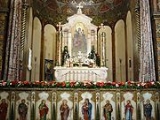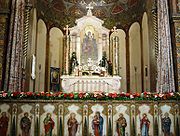
Altar crucifix
Encyclopedia
An Altar Crucifix or Altar Cross is a cross
placed upon an altar
, and is the principal ornament of the altar.
which was detatchable from its staff, and placed on the altar after processing. This would at first almost always a cross
rather than a true crucifix
; these began to be made specifically for altars in the late 11th century, and became more common from the 12th century, though they may have been expensive at first. By the start of the 13th century, treatises by Pope Innocent III
expect there to be a cross between two candles on the altar during the mass. This period was also the era when candlestick
s, also probably carried in procession at the start of a service, started appearing upon altars instead of nearby, and as such marked a rather large evolution in the adornment of altars. Around the 14th century, altar crosses were almost universally replaced by crucifices, probably now affordable by all churches, however, it was not until the Roman Missal of Pius V in 1570 that there is any mention of an obligation to have the crucifix on the altar.
Early Christians were not accustomed to publicly expose the cross or crucifix due to fear of subjecting it to the insults of pagans or scandalizing the weak. To avoid this, they often used symbol
s like the anchor
or trident
.
 The crucifix placed upon the altar is intended to serve as a reminder to the people in attendance and the celebrant of the believed nature of the Eucharist
The crucifix placed upon the altar is intended to serve as a reminder to the people in attendance and the celebrant of the believed nature of the Eucharist
as the actual body of Christ; the altar itself symbolically represents Golgotha. It is for this reason that Roman Law decrees it necessary to have the crucifix upon the altar whenever Mass is celebrated. Specifically, it is placed directly in between the Candlesticks in such a way that it is conveniently seen by the people. In some cases, to better fulfill this requirement, the crucifix is instead hung on the wall behind the altar, so that when the priest is facing the congregation the crucifix is not obstructed. In some churches the crucifix is suspended mid-air via strong, nearly invisible metal cords, directly above the altar itself.
While the crucifix is demanded to be upon or at least near the altar at all times, during the period of time from the first Vespers of Passion Sunday to the unveiling of the cross on Good Friday it is expected to be covered with a violet veil, except for the High Mass on the altar, when the veil is white, and Good Friday, when the veil is usually black. After Good Friday, until Holy Saturday it is necessary for all, including the bishop, the canons of the cathedral, and the celebrant to genuflect to the crucifix, which is in contrast to any other time of the year when the aforementioned are not required to genuflect.
when it comes to use of religious imagery. These crosses are traditionally, but not always, brought in as processional cross
es at the beginning of the religious service and placed at the altar in the sanctuary. When approaching the altar, the acolyte
is to bow at the cross to show respect toward the Lord
.
Cross
A cross is a geometrical figure consisting of two lines or bars perpendicular to each other, dividing one or two of the lines in half. The lines usually run vertically and horizontally; if they run obliquely, the design is technically termed a saltire, although the arms of a saltire need not meet...
placed upon an altar
Altar
An altar is any structure upon which offerings such as sacrifices are made for religious purposes. Altars are usually found at shrines, and they can be located in temples, churches and other places of worship...
, and is the principal ornament of the altar.
History
The first appearances of a cross upon the altar occurred approximately in the 6th century, although it remained unusual for several centuries, and even discouraged. When it was used, it seems to have been only during actual services, and probably a processional crossProcessional Cross
A processional cross is a crucifix or cross which is carried in Christian processions. Such crosses have a long history: the Gregorian mission of Saint Augustine of Canterbury to England carried one before them "like a standard", according to Bede. Other sources suggest that all churches were...
which was detatchable from its staff, and placed on the altar after processing. This would at first almost always a cross
Cross
A cross is a geometrical figure consisting of two lines or bars perpendicular to each other, dividing one or two of the lines in half. The lines usually run vertically and horizontally; if they run obliquely, the design is technically termed a saltire, although the arms of a saltire need not meet...
rather than a true crucifix
Crucifix
A crucifix is an independent image of Jesus on the cross with a representation of Jesus' body, referred to in English as the corpus , as distinct from a cross with no body....
; these began to be made specifically for altars in the late 11th century, and became more common from the 12th century, though they may have been expensive at first. By the start of the 13th century, treatises by Pope Innocent III
Pope Innocent III
Pope Innocent III was Pope from 8 January 1198 until his death. His birth name was Lotario dei Conti di Segni, sometimes anglicised to Lothar of Segni....
expect there to be a cross between two candles on the altar during the mass. This period was also the era when candlestick
Candlestick
A candlestick, chamberstick, or candelabrum is a holder for one or more candles, used for illumination, rituals, or decorative purposes. The name 'candlestick' derives from the fact that it is usually tall and stick-shaped.Candlesticks are also called candle holders...
s, also probably carried in procession at the start of a service, started appearing upon altars instead of nearby, and as such marked a rather large evolution in the adornment of altars. Around the 14th century, altar crosses were almost universally replaced by crucifices, probably now affordable by all churches, however, it was not until the Roman Missal of Pius V in 1570 that there is any mention of an obligation to have the crucifix on the altar.
Early Christians were not accustomed to publicly expose the cross or crucifix due to fear of subjecting it to the insults of pagans or scandalizing the weak. To avoid this, they often used symbol
Symbol
A symbol is something which represents an idea, a physical entity or a process but is distinct from it. The purpose of a symbol is to communicate meaning. For example, a red octagon may be a symbol for "STOP". On a map, a picture of a tent might represent a campsite. Numerals are symbols for...
s like the anchor
Anchor
An anchor is a device, normally made of metal, that is used to connect a vessel to the bed of a body of water to prevent the vessel from drifting due to wind or current. The word derives from Latin ancora, which itself comes from the Greek ἄγκυρα .Anchors can either be temporary or permanent...
or trident
Trident
A trident , also called a trishul or leister or gig, is a three-pronged spear. It is used for spear fishing and was also a military weapon. Tridents are featured widely in mythical, historical and modern culture. The major Hindu god, Shiva the Destroyer and the sea god Poseidon or Neptune are...
.
Catholic and Anglican churches

Eucharist
The Eucharist , also called Holy Communion, the Sacrament of the Altar, the Blessed Sacrament, the Lord's Supper, and other names, is a Christian sacrament or ordinance...
as the actual body of Christ; the altar itself symbolically represents Golgotha. It is for this reason that Roman Law decrees it necessary to have the crucifix upon the altar whenever Mass is celebrated. Specifically, it is placed directly in between the Candlesticks in such a way that it is conveniently seen by the people. In some cases, to better fulfill this requirement, the crucifix is instead hung on the wall behind the altar, so that when the priest is facing the congregation the crucifix is not obstructed. In some churches the crucifix is suspended mid-air via strong, nearly invisible metal cords, directly above the altar itself.
While the crucifix is demanded to be upon or at least near the altar at all times, during the period of time from the first Vespers of Passion Sunday to the unveiling of the cross on Good Friday it is expected to be covered with a violet veil, except for the High Mass on the altar, when the veil is white, and Good Friday, when the veil is usually black. After Good Friday, until Holy Saturday it is necessary for all, including the bishop, the canons of the cathedral, and the celebrant to genuflect to the crucifix, which is in contrast to any other time of the year when the aforementioned are not required to genuflect.
Protestant Churches
In many of the mainline Protestant denominations, such as the Lutheran and United Methodist, also have altar crosses; usually a cross without the body of Jesus Christ, as Protestantism to be more austereAniconism in Christianity
Christianity has not generally practised aniconism, or the avoidance or prohibition of types of images, but has had an active tradition of making and venerating images of God and other religious figures...
when it comes to use of religious imagery. These crosses are traditionally, but not always, brought in as processional cross
Processional Cross
A processional cross is a crucifix or cross which is carried in Christian processions. Such crosses have a long history: the Gregorian mission of Saint Augustine of Canterbury to England carried one before them "like a standard", according to Bede. Other sources suggest that all churches were...
es at the beginning of the religious service and placed at the altar in the sanctuary. When approaching the altar, the acolyte
Acolyte
In many Christian denominations, an acolyte is anyone who performs ceremonial duties such as lighting altar candles. In other Christian Churches, the term is more specifically used for one who wishes to attain clergyhood.-Etymology:...
is to bow at the cross to show respect toward the Lord
Christ
Christ is the English term for the Greek meaning "the anointed one". It is a translation of the Hebrew , usually transliterated into English as Messiah or Mashiach...
.

